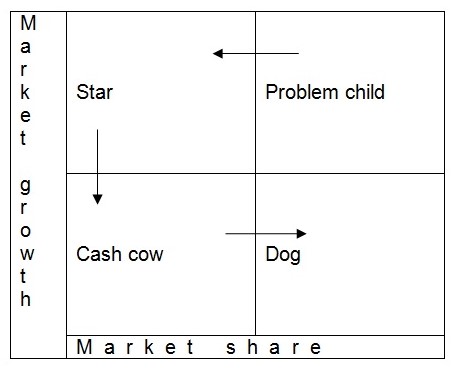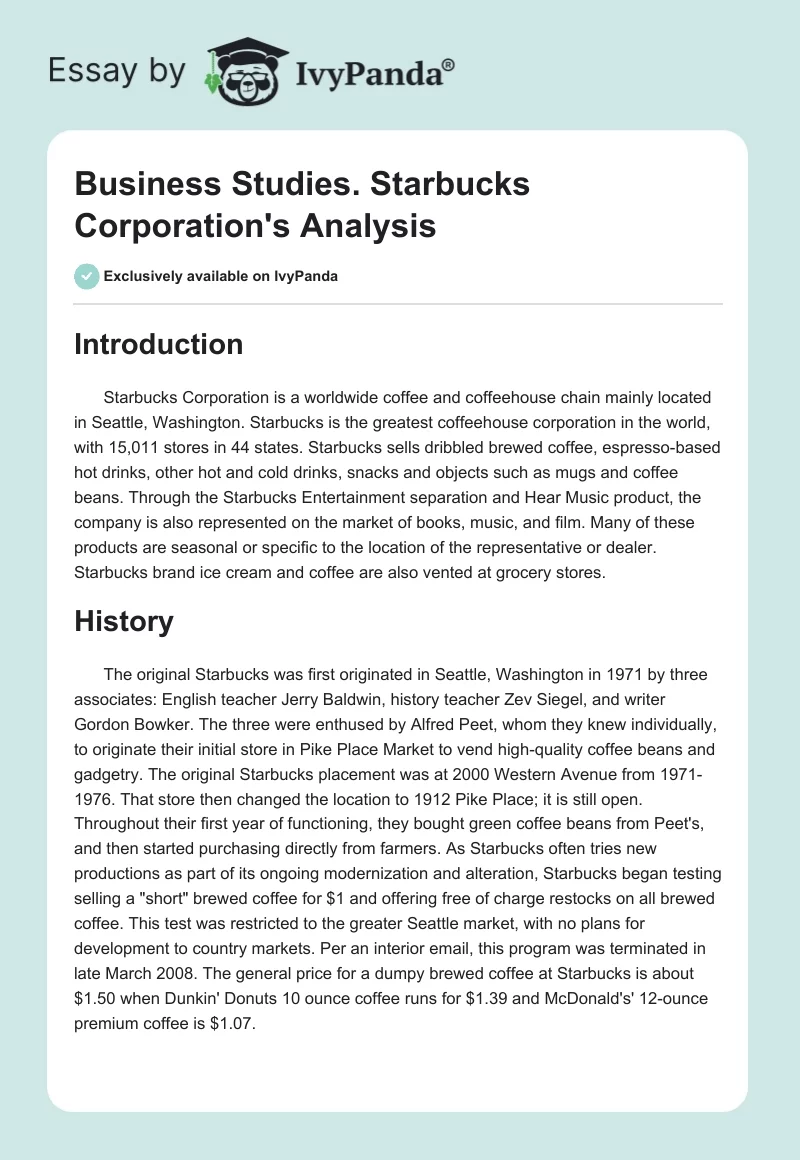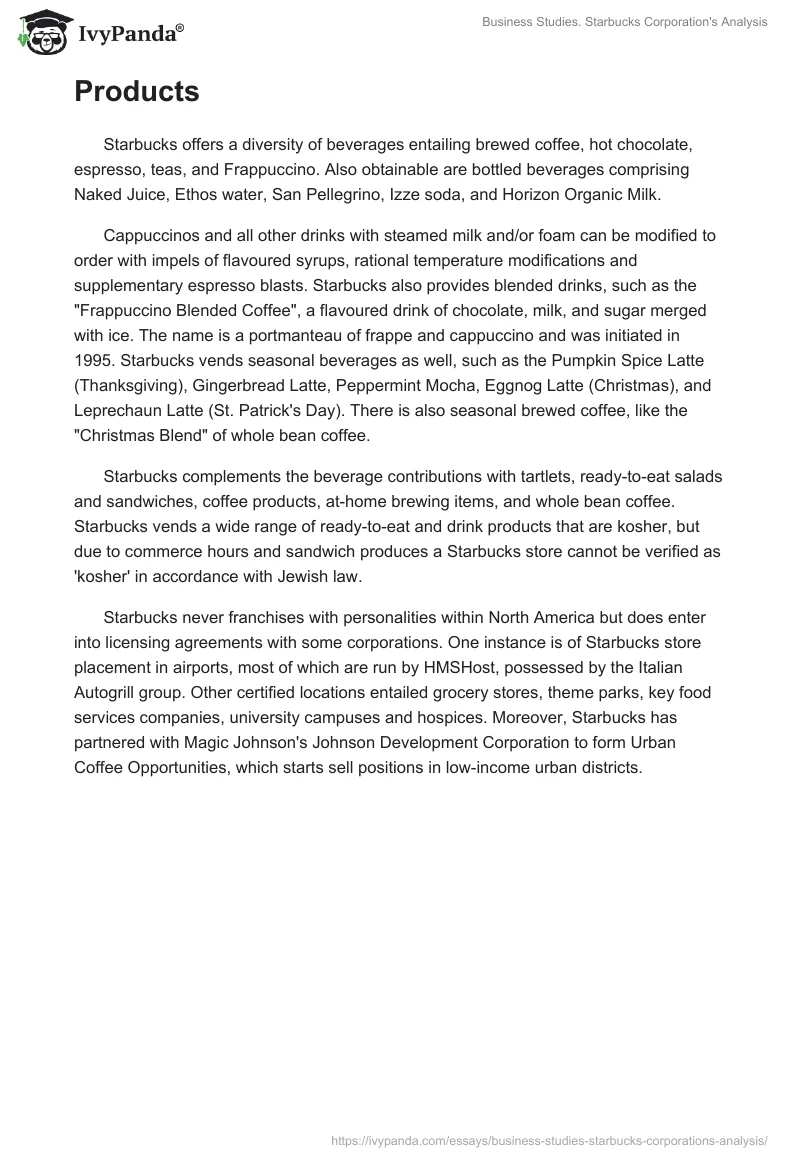Introduction
Starbucks Corporation is a worldwide coffee and coffeehouse chain mainly located in Seattle, Washington. Starbucks is the greatest coffeehouse corporation in the world, with 15,011 stores in 44 states. Starbucks sells dribbled brewed coffee, espresso-based hot drinks, other hot and cold drinks, snacks and objects such as mugs and coffee beans. Through the Starbucks Entertainment separation and Hear Music product, the company is also represented on the market of books, music, and film. Many of these products are seasonal or specific to the location of the representative or dealer. Starbucks brand ice cream and coffee are also vented at grocery stores.
History
The original Starbucks was first originated in Seattle, Washington in 1971 by three associates: English teacher Jerry Baldwin, history teacher Zev Siegel, and writer Gordon Bowker. The three were enthused by Alfred Peet, whom they knew individually, to originate their initial store in Pike Place Market to vend high-quality coffee beans and gadgetry. The original Starbucks placement was at 2000 Western Avenue from 1971-1976. That store then changed the location to 1912 Pike Place; it is still open. Throughout their first year of functioning, they bought green coffee beans from Peet’s, and then started purchasing directly from farmers. As Starbucks often tries new productions as part of its ongoing modernization and alteration, Starbucks began testing selling a “short” brewed coffee for $1 and offering free of charge restocks on all brewed coffee. This test was restricted to the greater Seattle market, with no plans for development to country markets. Per an interior email, this program was terminated in late March 2008. The general price for a dumpy brewed coffee at Starbucks is about $1.50 when Dunkin’ Donuts 10 ounce coffee runs for $1.39 and McDonald’s’ 12-ounce premium coffee is $1.07.
Products
Starbucks offers a diversity of beverages entailing brewed coffee, hot chocolate, espresso, teas, and Frappuccino. Also obtainable are bottled beverages comprising Naked Juice, Ethos water, San Pellegrino, Izze soda, and Horizon Organic Milk.
Cappuccinos and all other drinks with steamed milk and/or foam can be modified to order with impels of flavoured syrups, rational temperature modifications and supplementary espresso blasts. Starbucks also provides blended drinks, such as the “Frappuccino Blended Coffee”, a flavoured drink of chocolate, milk, and sugar merged with ice. The name is a portmanteau of frappe and cappuccino and was initiated in 1995. Starbucks vends seasonal beverages as well, such as the Pumpkin Spice Latte (Thanksgiving), Gingerbread Latte, Peppermint Mocha, Eggnog Latte (Christmas), and Leprechaun Latte (St. Patrick’s Day). There is also seasonal brewed coffee, like the “Christmas Blend” of whole bean coffee.
Starbucks complements the beverage contributions with tartlets, ready-to-eat salads and sandwiches, coffee products, at-home brewing items, and whole bean coffee. Starbucks vends a wide range of ready-to-eat and drink products that are kosher, but due to commerce hours and sandwich produces a Starbucks store cannot be verified as ‘kosher’ in accordance with Jewish law.
Starbucks never franchises with personalities within North America but does enter into licensing agreements with some corporations. One instance is of Starbucks store placement in airports, most of which are run by HMSHost, possessed by the Italian Autogrill group. Other certified locations entailed grocery stores, theme parks, key food services companies, university campuses and hospices. Moreover, Starbucks has partnered with Magic Johnson’s Johnson Development Corporation to form Urban Coffee Opportunities, which starts sell positions in low-income urban districts.
Boston Matrix

In accordance with the Boston Matrix, the products may be classified the following way:
- Problem child: These are productions with a low share of a high increase market. They devour resources and produce little in return. They absorb the most money as the entrepreneur attempts to augment market share. Probably this is featured coffee Organic Sumatra-Peru Blend. Rather interesting project, but the demand is rather changing, and unstable.
- Star: this category entails lots of brands, mainly cold shakes, as classic coffee requires a conservative approach, and reluctantly tolerates experiments. So, the star category is Frappuccino, Izze soda, Horizon Organic Milk. These are the exclusive products, which are rather popular among customers.
- Cash Cow: These are produced with a high share of a slow increase market, and create more than is spent in them. Such a product is Featured Coffee Kopelani Blend.
- Dog: Companies generally aim to get rid of such products, and never remind of them. Thus, any dog category product had been detected.
Product Life cycle
The fact is that it is of seasonal character. Thus, it is rather difficult to define the current stage in the Product Life Cycle analysis, as the number of sales increase with summer, and decrease with cold year periods, as the company makes the key accent on the cold drinks and shakes. But analyzing the allover amounts and the distinction of the company among all the others permits us to conclude, that the current stage is Maturity. As the product is consumed and referred to as the “Summer Drink” sales will eventually slow and reach maturity. As it recommends selling the flavours year-round making them available to those who still desire to consume them.
Perceptual Map

Promotion
There’s no such object as a free of charge iced coffee at Starbucks – at least not anymore. The world’s greatest sphere coffee chain has terminated what was suggested to be nearly five-week advertising after an e-mail voucher spread farther and wider than the company expected. Starbucks presenter Valerie O’Neil stated that the company had no approximation of how many free iced coffees it had sold or just how far and wide the e-mail had extended. “We’re getting on to follow it and see it spread,” O’Neil said. Asked if Starbucks would give this kind of suggestion another shot, O’Neil stated only, “We’re always looking at various ways we can distribute our productions.”
Price policy
Starbucks states the regular price of a drink at its U.S. amasses is in the $2 to $2.50 range. Most clients spent $3.50 to $4 on every visit. Thus, caffeine devotees with a $2.50 per day custom are about to have a $2.66 per day habit. Supposing 260 working and coffee-drinking days per year, that’s an extra $28.60 out of the yearly budget, for a total of $691 per year, not taking into account the tips.
SWOT analysis
Strengths:
- Starbucks Corporation is a rather beneficial company, earning in excess of $600 million in 2004. The corporation created an income of more than $5000 million in the same year.
- It is a worldwide coffee product created upon standing for fine productions and services. It has almost 9000 cafes in almost 40 countries.
- Starbucks was one of the luck Top 100 corporations to Work For in 2005. The corporation is an admired employer that charges its workforce.
- The company has powerful ethical charges and a principled mission declaration as follows, ‘Starbucks is devoted to a role of environmental leadership in all aspects of this business.’
Weaknesses:
- Starbucks has a standing for new product expansion and creativity. Nevertheless, they stay susceptible to the probability that their improvement may hesitate over time.
- The company has a powerful presence in the USA with more than three sectors of their cafes placed in the home market. It is often stated that they need to look for a collection of countries, in order to increase business risk.
- The company is charged with a key competitive benefit, the vending of coffee. This could make them decelerate to diversify into other spheres should the need happen.
Opportunities:
- Starbucks is rather good at taking benefit of capabilities.
- In 2004 the company produced a CD-burning service in their Santa Monica (California USA) cafe with Hewlett Packard, where clients make their own music CDs.
- New productions and services can be traded in their cafes, such as Fair Trade productions.
- The corporation has the capability to enlarge its global procedures. New marketplaces for coffee such as India and the Pacific Rim populations are starting to emerge.
- Co-branding with other producers of food and drink, and brand licensing to producers of other goods and overhauls both have the possibility for further expansion.
Threats:
- Nobody knows if the market for coffee will increase and stay in favour with consumers, or whether another type of infusion or leisure action will substitute coffee in the future.
- Starbucks is subjected to increases in the cost of coffee and dairy productions.
- Since its commencement in Pike Place Market, Seattle in 1971, Starbucks’ achievement has lead to the market admission of many contestants and copycat products that pose.
Conclusion and recommendations
The only recommendation that may be offered here is the further market expansion, and increase of product quality. Such expansions only signify the validity of the company and increase the credit of customer’s trust.


